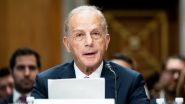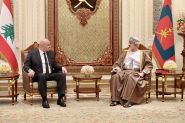
The Maronite Church and the Basilica of Saint Peter in Rome celebrated a very special event: the installation of a mosaic portraying Saint Charbel, placed in close proximity to the tomb of Saint Paul VI. It was Saint Paul VI who presided over the canonization mass of the hermit from Annaya on October 9, 1977.
During that time, it’s worth noting that Lebanon was emerging from the “two-year war.” the canonization of Saint Charbel stood as a particularly emotional moment — like a “faithful pause,” as described back then by a prominent journalist. The war resumed in different forms and dragged Lebanon to the bottom of the abyss.”
In his homily at the beatification mass on December 3, 1965, Pope Paul VI thanked the Lebanese people for the “warm welcome extended by the entire country, without distinction of race or religion,” during his stop in Beirut on his way to Bombay. Speaking to the representatives of Lebanon present at the ceremony, he declared, “The gathering of so many sons and daughters of noble Lebanon — a privileged crossroads and a traditional meeting place between Africa, Asia, and Europe — at the glorious tomb of Peter emphasizes the significance of the Church's action today.”
At the canonization mass, Paul VI further asserted: “Today, the entire Church, spanning from East to West, is called to rejoice greatly. Our hearts turn to the Heaven, where we now know with certainty that Saint Charbel Makhlouf is embraced in the incommensurable joy of the saints, in the radiant presence of Christ, praising and interceding for us. Our gaze also turns to the land where he once lived, the cherished country of Lebanon (...). The turmoil of recent events marked his face with deep wrinkles and cast a significant shadow over the paths of peace. However, you are aware of our enduring sympathy and constant affection. With you, we maintain a steadfast hope for renewed collaboration among all the sons of Lebanon.”
Symbol of Gathering
Today, once again, Saint Charbel, who extends the foundational mission of Saint Maron, stands as a gathering sign for the Lebanese — a call to unity and an unceasing prayer for them to collectively build Lebanon. This embodies the core of the invaluable “model of pluralism” they are urged to present to both the East and the West, as articulated by Pope John Paul II.
For Father Louis Matar, the treasurer of the Annaya convent and custodian of its miracles, “the intercession of the great hermit knows no geographical limits or religious boundaries.” He asserted, “All those who invoke him witness the fruits of sanctity, whether through healing or as a source of solace in times of suffering." Indeed, to visit Annaya, no baptism certificate is necessary.
“The Lord grants him everything because Saint Charbel refused Him nothing; for nothing is impossible for God,” adds Father Matar.
On the occasion of the hanging of a mosaic piece portraying Saint Charbel in the Vatican crypt, the “profound wrinkles” carved by the war on Lebanon haven’t yet faded — quite the contrary. They seem to have deepened amid the celebration of the centenary of Greater Lebanon.
Therefore, it is imperative to pray for the powerful intercession of Saint Charbel and the almost unbelievable abundance of solace and healing he continuously bestows, often in the most intimate moments. May this assistance guide the Lebanese and all the peoples of the Middle East in awakening to the God of peace. In the words of the prophet Isaiah, “May they forge plowshares from their swords and pruning hooks from their spears,” so that “never again shall one nation raise the sword against another.”
Read more





Comments